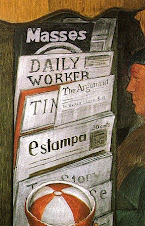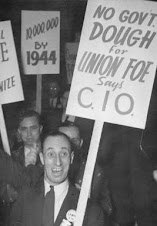In hard times, Cleveland blacks' views about immigrants shifting
By Robert L. Smith, The Plain Dealer
CLEVELAND, Ohio -- The last wave of newcomers poured into the city in the 1960s, in the closing years of the Great Migration. Like immigrant groups before them, the migrants from the Deep South soon decided that Cleveland had enough. Enough new people. Enough foreigners.
For years, proposals to welcome new immigrants to a fading city rarely found support in the black community. Until now.
With the city and county facing crippling population losses, a key group may be coming around to the idea that Cleveland needs to welcome the world -- before the world passes by. People and organizations representing blacks are, in a marked turnaround, beginning to speak of immigrants as part of the solution.
Recently, a local black think tank, PolicyBridge, released a study concluding that immigrants are good for the black community and that Cleveland should begin recruiting them aggressively.
The report follows several pro-immigrant steps by Mayor Frank Jackson, who once questioned the value of immigrants and now describes them as part of his strategy for success.
Meanwhile, some young black leaders wonder what the region has been waiting for. Miesha Wilson Headen, a new member of the Richmond Heights City Council, says that immigrant-owned restaurants like Taj India Palace -- run by two cousins from Bangladesh -- are doing more than adding new flavors to her suburb. They're expanding the tax base.
"I think as an elected official I'm allowed to love you for that," she said. "The owners of these businesses all live around here. They're employing people. They're working hard, and I'm glad to have them."
As a mother, Wilson Headen has another motivation. She does not think her two young sons have a future in Northeast Ohio if its economy does not rebound. She has read that high-skill immigrants create jobs in the new economy and she hopes it's true.
So do other opinion leaders in the black community, where the jobs issue looms critical in any immigration debate.
NAACP helps plan international welcome center
As noted in the PolicyBridge report, high-skill immigrants bring talents that local companies say they need to compete in the global economy. Also, they tend to be entrepreneurial, launching businesses and creating jobs.
The researchers could have been talking about Monte Ahuja, who came from India as a young man to earn a master's degree and founded Walton Hills-based Transtar Industries. Ahuja built the company into one of the largest car parts suppliers in the world, creating hundreds of local jobs.
Low-skilled immigrants, on the other hand, are more likely to take low-wage and factory jobs, work that can be done by people already here. That's a sensitive issue in a minority community with high unemployment.
Immigrant success stories often ring hollow in the black community, where many are loath to envision another new group leaping ahead of them.
"It always appears that people come from other places and they push us down a peg again," said Stanley Miller, executive director of the Cleveland NAACP.
Miller is no foe of immigrants. He serves, along with Jackson, on a committee planning an international welcome center for Cleveland. The center would reach out to newcomers with services that might entice them to make a life here.
"I think we do need to bring fresh blood," Miller said. "My issue has always been, 'What happens to the people already here?' "
Miller wants any immigrant-recruitment strategies to seek a shared prosperity, one that ensures the black community rises with a new immigrant wave.
That's one reason he and other black civic leaders stress job creation as a key component of a welcome effort.
"If the people come in and create jobs, that's great," said C. Ellen Connally, a charter member of the Cuyahoga County Council. "If you attract people who come and take jobs from citizens, no one's going to be happy about that."
In her Shaker Square neighborhood, Connally sees trends that make her feel good about immigrants. Couples from Asia have been moving in, near their jobs in the medical and research facilities of University Circle.
They shop. They spend money. They send their kids to local schools.
"That's all positive," Connally said.
Plus, she said, they help to counter "our tremendous problem with population loss."
Stagnant population changes some views
Cleveland this decade earned a dubious distinction: America's fastest-declining major city not hit by a natural disaster. The city, like Connally's district, has lost about 10 percent of its people since 2000, according to the U.S. Census Bureau.
Meanwhile, Cuyahoga County is America's fastest-declining major county, and the regional population has stagnated.
Fewer people mean less federal aid, less political clout, more empty houses and less investment by business and industry, the PolicyBridge report notes.
The grim statistics turned heads and probably helped to change some views. In late 2008, Mayor Jackson was still promoting "homegrown solutions" to the city's woes. But by August 2010, he had joined the effort to create an international welcome center.
Recently, Jackson became the first Midwest mayor to endorse the Partnership for a New American Economy, a crusade by big city mayors and corporate CEOs to promote comprehensive immigration law reform, which could help struggling cities attract immigrants.
In recent interviews, Jackson said his views on immigration have evolved but have not really changed. He said he sees immigrants and international students as a key part of a larger strategy to boost Cleveland with new talent and investment.
"We know that a welcome center, along with other policies, will make us a much more friendly community," he said.
Fears that low-skilled immigrants will hurt low-skilled workers are warranted, according to the Policy Bridge study. But the study also cites evidence that immigrants, by bolstering the local economy, create opportunities for all.
"They lift the floor. We believe that's the bigger issue," said Randell McShepard, an executive with RPM International and the founder of PolicyBridge, a public-policy think tank that focuses on issues critical to the black community.
Its latest report, "Immigration: Path to Prosperity or Calamity?" followed a study into black and white flight from Cleveland and the ramifications, mostly bad, of a shrinking city.
Immigrants loomed as a likely solution, McShepard said.
"If new folks can buy abandoned homes and rebuild neighborhoods, that's going to create jobs," he said. "Immigration could be our counteraction to population loss. And it helps us keep our work force competitive."
The report suggests that immigrant-attraction strategies coincide with efforts to attract professional and middle-income black families from other cities. It also recommends highlighting the shared travails faced by immigrants and minorities, to temper resentment and foster cooperation.
"Ultimately, we think that immigrants can benefit low-skilled workers," McShepard said. "We think they would help our community as well as any other."
Subscribe to:
Post Comments (Atom)










































No comments:
Post a Comment